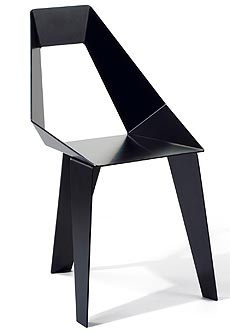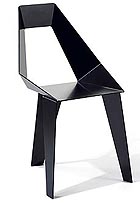
October 30 - November 5
MAK-Applied Arts / Contemporary Art: AXIOME - Examples of a counter-strategy
More than just practical
Bernhard Buchegger, Michael Denoth, and Thomas Feichtner (design studio Buchegger, Denoth, Feichtner) design objects without taking industrial manufacturing technology, economic motivation, or sales-promotion into consideration. Their objects are currently exhibited in the MAK under the title of "AXIOMS" and it is obvious that the trio`s philosophy is a very good one. Objects with a charmingly unconventional style, manufactured with great precision by traditional handicraftsmen, convey pure beauty and even resonate poetry.
The versatile basic building blocks used by the three designers are triangles and trapezoids. Ingenious ways of folding these geometric shapes transform them into a multitude of objects. The AXIOM chair is manufactured out of a powder coated aluminum sheet, which evolves into a trapeze-shaped seating with a side- and neck-rest around an empty backspace. The clearly defined edges give support and at the same time leave space for a new view.
The Evry-Lamp cannot deny its geometric kinship to a triangle. The soft slope, making the shape of a banana evident, glows and swings delicately. The black Table Chair floats on its chrome leg as if it were a reduced, narrow box, and it can be opened like a casket. Following its axiom nature the white leather inside has triangular-trapezoidal forms. The leather Lounge Chair is also in line with these geometrical figures. Its sloped seating surface, edges and bevels invite you to sink into a padded landscape.
Even the small objects such as the silver cutlery Cutt and its aluminum handholds clearly show that the triangular form is most suitable for design. Cutt not only fits nicely into your hands and is a delightful form of functional art. "AXIOMS" prove that style can walk off with the first prize if commercial interests do not call the tune.
(1010 Wien, Stubenring 5, until 2. 12. 2007)
www.mak.at
Jüdisches Museum Wien: Best of Women - Feminine dimensions in Judaism
Powerful Jewish women
The fascinating exhibit in Vienna`s Jewish Museum, curated by Gabriele Kohlbauer-Fritz and Wiebke Krohn, demonstrates how powerful Jewish women are and always have been. Different aspects of their strengths are made visible through the compact and carefully arranged exhibit (architecture: Nicole David, Natalie Neubauer). The visitor will not exclusively be confronted with the role that women played in a religious context, but also with how important salons were, such as those lead by Fanny Arnstein or Cäcilie von Eskeles for the emancipation of Jewish women.
The portraits depict women who were assimilated or who were even baptized later in their lives. Many viewers are probably unaware of the fact that Bertha Pappenheim, who became well known as Freud`s "hysterical Anna O.", engaged herself in female slavery and prostitution and later lead an orphanage for Jewish girls.
Next to all of these positive examples of Jewish women, you will also find the negative example of Lilith, the "first of all women". As mythology has it she was the first woman born after Adam and unconditionally opposed to subordinate herself to his sexual greediness. After leaving him she murders newborn babies. Magnificent amulets with the symbolic strength of resistance offer proof for this story.
The exhibits thematic abundance can be confusing, but on the other hand it is this plenitude that offers a differentiated view of a complex topic necessitating such diligence.
(1010 Wien, Dorotheergasse 11, until 18. November 2007)
www.jmw.at
Technopolis Athens: 1st Athens Biennial 2007
In the shadow of the Acropolis
As much as the bustling cultural metropolis on the Bosporus charms its visitors, in the hands of curator Hou Hanru the 10th Biennale in Istanbul crumbled into an event without any remarkable highlights. The actual art exhibit is the city itself and life going on in its multitudinous facets.
The voyage continues to Athens and its first Biennale, which is more easily assessable than any other. The contrast to Istanbul is obvious: Athens is a charming town seemingly sleeping since antiquity. The concept of holding the Biennale in the cultural centre Technopolis is ingenious. The curators (Xenia Kalpaktsoglou, Poka-Yio and Augustine Zenakos) successfully bundled this major event with the simple method of narration; it is a story told in six chapters.
The title "Destroy Athens" reveals concepts such as identity, culture and deconstruction, as well as local aspects, which flow into the thematic issue. The exhibit offers a direct connection to the city it is taking place in and thereby has both a lasting effect and signalizes the involvement with the immediate lebensraum, initiating a dialogue without using populist vocabulary.
Recruiting stars of the art world or adopting sensational themes was just as obsolete as a one-dimensional illustration of theoretical digressions. Art is a language that needs no translation.
"Destroying Athens" tells a story. The visitor is guided from one painting to the next, from one scene to the next, through six chapters of the history of creation. A video-installation by Julian Rosenfeldt and Piero Steinle, showing buildings being blasted after the Second World War represents the histrionic anacrusis of the exhibit. Ioannis Savidis, on the other hand, constructs fictitious historical utopias, dealing with the reproduction of stereotypes, manipulation of history or the mechanism of representation. A dream world is composed by Folkert de Jong`s monumental sculptural installation together with John Kleckner`s aquarelle paintings. Stefanos Tsivopoulos` spacious mural paintings form a kind of sacral zone, which transfer Byzantine iconography into the present day. At the same time it offers a setting for a sketch by Pablo Picasso documenting the Greek resistance against the Nazis.
Among the classic artists exhibited at the Biennale, whose main sponsor is the Deutsche Bank, are hypes such as assume vivi astro focus or Aidas Bareikis, Charles Avery, John Bock, Peter Dreher, Olaf Nicolai, and Julian Rosenfeldt. The probability of making new discoveries among the group of 60 artists is not very high, but not impossible. Off to Lyon!
(118 54 Athens, 100 Peiraios Street, until 18. 11. 2007)
www.athensbiennial.org
Kunsthalle Wien: Viva la Muerte - Art and Death in Latin America
Death as a life strategy
Death is banned in the modern western world - for example by being pushed into a sterile hospital. Modern efforts to overcome mortality have been succeeded by postmodern endeavors to deconstruct immortality. However, both scenarios have one common factor: a life strategy, said the sociologist Zygmunt Bauman
In most Latin American societies this life strategy is considered to be common sense. The exhibit "Viva la Muerte!" takes a mediated position towards the ritual and cultic integration of death into every day life. Death is not exposed to voyeuristic gazing or as a mental principal of being; it simply evolves out of the contemporary artwork shown. Bastienne Schmidt`s photo series shows different types of mourning in different countries in large black and white formats. Pedro Reyes created kitschy figures in the style of the "Santa Muerte" cult.
However, the psychological or pop cultural handling of death is only relevant to a part of the displayed works. Others deal with the social circumstances that lead to violent death. The skull with the clown nose, created by the Brazilian artist Vik Muniz, is to be seen in the context of military dictatorships of the Seventies. Critical art had to use a type of "hidden language". Muniz called these subversive symbols "a semiotic black market". Those who worked analytically or poetically used the most convincing resources. Among them is the artist Francis Alys, who runs through Mexico City with a gun until the police stop him and the body artist Regina José Galindo, whose bloody footprints in front of the courthouse are meant to remind everyone of the atrocities of the Civil War in Guatemala.
Death as a life strategy tries to reveal something about the "cultural and social organization" (Bauman) of a society. However, the exhibit is not completely successful in tracing this revelation. Santiago Sierras or Teresa Morgolies brute Realism easily topples into Nobel Prize winner Octavio Paz` magniloquence of being: "Our cult of the dead is a cult of life, as all love thirsty for life longs for death". And at no time is one informed that the title of the exhibit "Viva la Muerte" is actually a fascist slogan, used by General Franco`s followers during the Spanish Civil War (1936 -1939) when they murdered thousands of republicans and anarchist opponents.
(1070 Wien, Museumsplatz 1, until 17. February 2008)
www.kunsthallewien.at


 Teilen
Teilen





